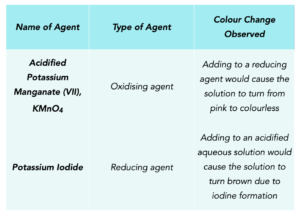Oxidation & Reduction (GCSE Chemistry)
Oxidation & Reduction
Metal Oxides
Oxidation
- Metals react with oxygen. When metals are in the presence of oxygen, they gain oxygen, forming substances called metal oxides.
For example, when we react iron with oxygen, we can form iron (III) oxide. This is the equation:
4Fe + 3O2 → 2Fe2O3
Iron + Oxygen → Iron (III) oxide
- These reactions are oxidation reactions. When metals react with oxygen, the process is called oxidation. Oxidation is the process of adding oxygen to a substance.
- The oxidising agent provides oxygen. The chemical which provides oxygen is known as the oxidising agent.
- Oxidation is also defined as the loss of electrons. When metals are added to oxygen they form positive ions by losing electrons.
For example, sodium reacts with oxygen to make sodium oxide.
4Na + O2(g) → 2Na2O(s)
In the formation of sodium oxide, sodium atoms change into sodium ions, in making the ionic compound, sodium oxide. Electrons are lost from sodium atoms; sodium atoms have been oxidised.
We can write this as an ionic equation. Electrons are written with the symbol e–. If electrons are lost, they are written on the product side of the equation.
4Na(s) → 4Na+ + 4e–
Reduction
- Reduction is the loss of oxygen. If a substance loses oxygen during a reaction, this is known as reduction. An example of this is a metal being extracted from an oxidised state.
For example, we can reduce copper oxide to form copper. This is the equation:
2CuO + C → 2Cu + CO2
Copper (II) oxide + Carbon → Copper + Carbon dioxide
- Reduction is the gain of electrons. When oxygen is removed from a metal oxide, electrons are added to the metal ions, and they form metal atoms.
For example, in copper oxide, copper exists in the form of copper (II) ions, Cu2+ ,as it bonds ionically with oxygen. When oxygen is removed from Cu2+ ions, electrons are added to the Cu2+ and copper atoms are formed. The copper ions have been reduced.
As electrons are gained, they are written on the reactant side.
Cu2+ + 2e– → Cu
- The reducing agent removes oxygen. The chemical which removes oxygen is known as the reducing agent.
Colour Changes in Redox Reactions
We can observe redox reactions using colour changes. You need to know about the colour changes with acidified potassium manganate (VII) and potassium iodide, seen in the table below.

Oxidation and reduction are chemical reactions in which electrons are transferred from one molecule to another. Oxidation is the process of losing electrons, while reduction is the process of gaining electrons. These reactions are often referred to as “redox” reactions.
Oxidation and reduction are two sides of the same coin and always occur together. In any redox reaction, one substance is oxidized and another is reduced. The transfer of electrons from the oxidized substance to the reduced substance is what drives the reaction.
Examples of oxidation and reduction reactions include the reaction between iron and oxygen to form rust, the reaction between a metal and an acid to produce hydrogen gas, and the reaction between glucose and oxygen in cellular respiration.
Oxidation and reduction play a crucial role in biological systems, as they are involved in processes such as cellular respiration and photosynthesis. In cellular respiration, glucose is oxidized to produce energy, while in photosynthesis, carbon dioxide is reduced to form sugars.
Oxidation and reduction reactions can be recognized by changes in the oxidation state of the substances involved in the reaction. The oxidation state is a measure of the number of electrons an atom has lost or gained, and changes in oxidation state indicate that a redox reaction has taken place.
Understanding oxidation and reduction is important in chemistry because it helps us understand the behavior of substances and the mechanisms of chemical reactions. This knowledge is essential for fields such as organic chemistry, biochemistry, and materials science, and has a wide range of practical applications, from energy production to waste management.
The study of oxidation and reduction is closely related to other areas of chemistry, such as thermodynamics, electrochemistry, and chemical kinetics. Understanding redox reactions is essential for studying these fields and for advancing our understanding of chemical processes at the molecular level.





Still got a question? Leave a comment
Leave a comment